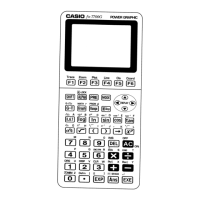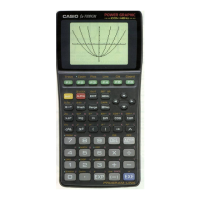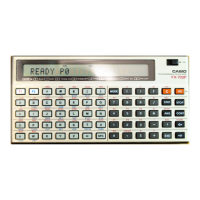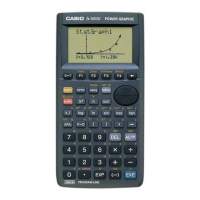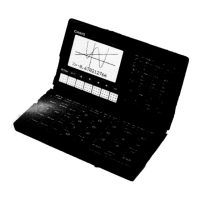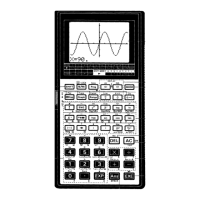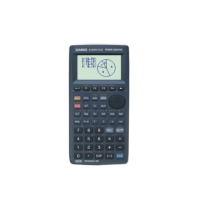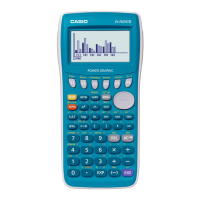Do you have a question about the Casio FX-7700GB and is the answer not in the manual?
Explains the calculator's keyboard layout, including primary and shifted functions, and key operations.
Describes various operational modes like COMP, STAT, SD, REG, MAT, G-TYPE, and how to change them.
Covers setting up the calculator, including angular measurement units, display format, decimal places, and significant digits.
Details fundamental operations like clearing memory, basic calculations, editing, and using the answer function.
Explains calculations in binary, octal, decimal, and hexadecimal number systems.
Covers matrix operations including input, arithmetic, and specific matrix functions.
Explains how to store and recall functions and formulas using the calculator's memory.
Describes the calculator's display capabilities for graphics and text, including clearing displays.
Provides details on calculation priority, value input limits, and error handling.
Covers basic arithmetic operations, including calculations using parentheses and order of operations.
Explains how to convert between degrees, radians, and grads for angular measurements.
Details the usage of sine, cosine, tangent, and their inverse functions.
Covers calculations involving logarithms (common and natural) and exponential functions.
Explains the use of hyperbolic sine, cosine, tangent, and their inverse functions.
Introduces other mathematical functions like reciprocals, factorials, and combinations.
Describes how to convert between rectangular and polar coordinate systems.
Details calculations for permutations (nPr) and combinations (nCr).
Explains how to perform calculations with fractions, including mixed and improper forms.
Covers calculations using engineering symbols and units (e.g., kilo, mega).
Explains how to set decimal places, significant digits, and display formats for results.
Demonstrates how to use value memories (A-Z) for storing and recalling calculation results.
Covers calculations within the BASE-N mode, including conversions and arithmetic operations.
Explains the process of performing integration calculations using Simpson's rule.
Covers statistical calculations for a single dataset, including mean, standard deviation, and variance.
Details statistical analysis for two variables, including linear, logarithmic, and exponential regression.
Provides important notes and tips for performing statistical calculations accurately.
Illustrates various statistical calculations with practical examples.
Introduces the graphing capabilities of the calculator, covering different graph types.
Explains how to graph functions in the rectangular coordinate system, including manual input and built-in functions.
Details how to draw graphs in the polar coordinate system, including manual input.
Covers graphing parametric equations, specifying range parameters for t.
Explains how to graph inequalities and visualize the solution regions.
Shows how to graph integration results and visualize the area under a curve.
Describes graphing probability distribution functions like normal and binomial.
Explains how to create statistical graphs like bar graphs and histograms from data.
Covers graphing paired data, such as scatter plots and regression lines.
Details advanced graphing functions like trace, zoom, and plotting points.
Provides practical examples demonstrating various graphing techniques.
Introduces the programming mode, memory management, and checking memory status.
Explains common error messages encountered during programming and their meanings.
Details how to count program steps and check remaining memory.
Lists and explains various commands used in calculator programming, including jumps and subroutines.
Explains unconditional and conditional jumps for controlling program flow.
Covers the use of subroutines for modular programming and code reuse.
Describes how to use array memory for storing and manipulating data in programs.
Explains how to display text messages and prompts within programs.
Shows how to integrate graphing capabilities into calculator programs.
Details the procedure for connecting two graphic units for data transfer.
Explains how to connect the calculator to a PC for data communication.
Provides an overview of the program communications mode settings and parameters.
Describes how to configure parameters like baud rate, parity, and data bits for communication.
Outlines the steps for transferring a single program between two calculators.
Explains how to transfer all stored programs from one unit to another.
Advises on when and how to replace the calculator's batteries.
Provides detailed instructions for replacing the main and backup batteries.
Notes regarding battery replacement and power supply.
Explains the automatic power-off feature to conserve battery life.
Details the procedure for resetting the calculator to its default settings.
Lists and describes various manual calculation modes and functions.
Provides a reference for function input commands and their usage.
Lists common error messages, their meanings, and characteristics.
Specifies the valid input ranges for various functions and operations.
Lists the technical specifications of the calculator, including memory, display, and dimensions.
Explains the calculator's keyboard layout, including primary and shifted functions, and key operations.
Describes various operational modes like COMP, STAT, SD, REG, MAT, G-TYPE, and how to change them.
Covers setting up the calculator, including angular measurement units, display format, decimal places, and significant digits.
Details fundamental operations like clearing memory, basic calculations, editing, and using the answer function.
Explains calculations in binary, octal, decimal, and hexadecimal number systems.
Covers matrix operations including input, arithmetic, and specific matrix functions.
Explains how to store and recall functions and formulas using the calculator's memory.
Describes the calculator's display capabilities for graphics and text, including clearing displays.
Provides details on calculation priority, value input limits, and error handling.
Covers basic arithmetic operations, including calculations using parentheses and order of operations.
Explains how to convert between degrees, radians, and grads for angular measurements.
Details the usage of sine, cosine, tangent, and their inverse functions.
Covers calculations involving logarithms (common and natural) and exponential functions.
Explains the use of hyperbolic sine, cosine, tangent, and their inverse functions.
Introduces other mathematical functions like reciprocals, factorials, and combinations.
Describes how to convert between rectangular and polar coordinate systems.
Details calculations for permutations (nPr) and combinations (nCr).
Explains how to perform calculations with fractions, including mixed and improper forms.
Covers calculations using engineering symbols and units (e.g., kilo, mega).
Explains how to set decimal places, significant digits, and display formats for results.
Demonstrates how to use value memories (A-Z) for storing and recalling calculation results.
Covers calculations within the BASE-N mode, including conversions and arithmetic operations.
Explains the process of performing integration calculations using Simpson's rule.
Covers statistical calculations for a single dataset, including mean, standard deviation, and variance.
Details statistical analysis for two variables, including linear, logarithmic, and exponential regression.
Provides important notes and tips for performing statistical calculations accurately.
Illustrates various statistical calculations with practical examples.
Introduces the graphing capabilities of the calculator, covering different graph types.
Explains how to graph functions in the rectangular coordinate system, including manual input and built-in functions.
Details how to draw graphs in the polar coordinate system, including manual input.
Covers graphing parametric equations, specifying range parameters for t.
Explains how to graph inequalities and visualize the solution regions.
Shows how to graph integration results and visualize the area under a curve.
Describes graphing probability distribution functions like normal and binomial.
Explains how to create statistical graphs like bar graphs and histograms from data.
Covers graphing paired data, such as scatter plots and regression lines.
Details advanced graphing functions like trace, zoom, and plotting points.
Provides practical examples demonstrating various graphing techniques.
Introduces the programming mode, memory management, and checking memory status.
Explains common error messages encountered during programming and their meanings.
Details how to count program steps and check remaining memory.
Lists and explains various commands used in calculator programming, including jumps and subroutines.
Explains unconditional and conditional jumps for controlling program flow.
Covers the use of subroutines for modular programming and code reuse.
Describes how to use array memory for storing and manipulating data in programs.
Explains how to display text messages and prompts within programs.
Shows how to integrate graphing capabilities into calculator programs.
Details the procedure for connecting two graphic units for data transfer.
Explains how to connect the calculator to a PC for data communication.
Provides an overview of the program communications mode settings and parameters.
Describes how to configure parameters like baud rate, parity, and data bits for communication.
Outlines the steps for transferring a single program between two calculators.
Explains how to transfer all stored programs from one unit to another.
Advises on when and how to replace the calculator's batteries.
Provides detailed instructions for replacing the main and backup batteries.
Notes regarding battery replacement and power supply.
Explains the automatic power-off feature to conserve battery life.
Details the procedure for resetting the calculator to its default settings.
Lists and describes various manual calculation modes and functions.
Provides a reference for function input commands and their usage.
Lists common error messages, their meanings, and characteristics.
Specifies the valid input ranges for various functions and operations.
Lists the technical specifications of the calculator, including memory, display, and dimensions.
| Model | FX-7700GB |
|---|---|
| Type | Scientific |
| Display | LCD |
| Algebraic Logic | Yes |
| Programming | Yes |
| Functions | Trigonometric, logarithmic, exponential, statistical |
| Power Source | Battery |
| Dimensions | 165 mm x 80 mm x 13 mm |
